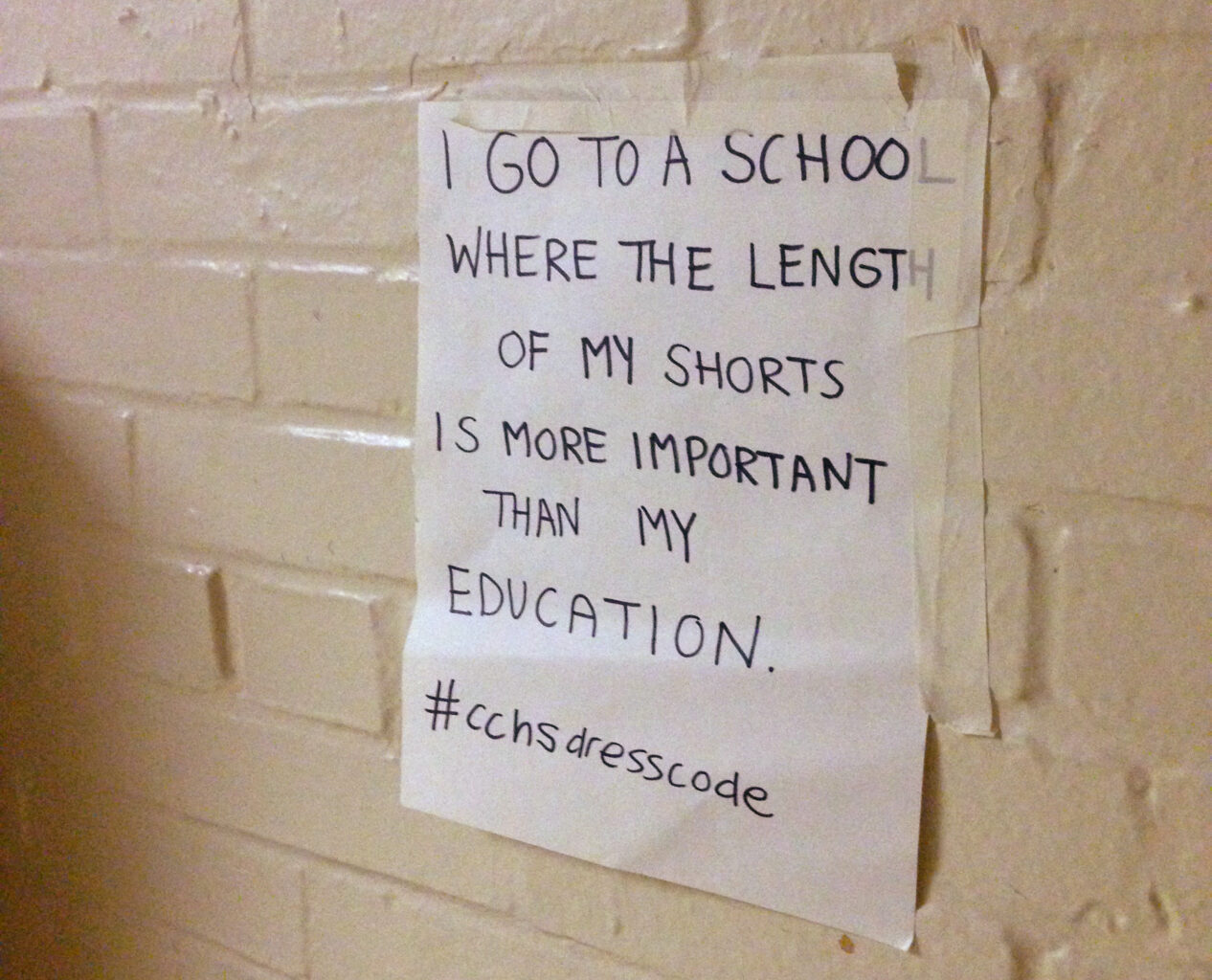On August 14, student-produced signs protesting the enforcement of the CCHS dress code appeared across campus. Photo by Louise Platter.
By TIERNAN O’NEILL – Viewpoints Editor
“‘I AM A SIXTEEN YEAR OLD GIRL. IF YOU ARE SEXUALIZING ME, THEN YOU ARE THE PROBLEM.’”
“OUR ADMINISTRATION SAYS THAT BOYS CAN’T FOCUS IN SCHOOLS BECAUSE OF WHAT GIRLS ARE WEARING. GIRLS CAN’T FOCUS IN SCHOOL BECAUSE THEY ARE WORRIED THEY MIGHT GET CALLED OUT FOR WEARING A TANK TOP AND SHORTS IN 85 DEGREE WEATHER.”
These are just two of the messages that were printed and handwritten on signs posted across the Clarke Central High School campus on Aug. 14, yet only a week later, none remain.
Each poster, placed by anonymous students protesting the newly important CCHS dress code, concluded with the rallying cry: “YOUR DRESS CODE PROMOTES RAPE CULTURE AND SEXISM.”
While the group’s signs were sensational, their messages remain important and necessary.
CCHS administrators have placed a renewed emphasis on enforcing the Clarke County School District clothing policies and the CCHS dress code this year. The administration team decided pulling students in violation of dress code out of classrooms and sending them to in-school suspension is the most effective way to ensure that the dress code is followed.
Assistant Principal Dr. Sheila Dunham offered a defense of this crackdown.
“I think all of (the administrators) felt like we didn’t have a handle on the dress code last year,” Dunham said. “If you don’t start out at the beginning of the year it’s hard to get a handle on it later in the year. So we’re just going around to classrooms and calling students out into the hallway just to talk to them. If it’s a borderline issue we can let them go back into class, and if it’s an issue that needs to be addressed then we follow what it says in the code of conduct.”
The current dress code is trying to prevent discrimination while institutionalizing it at the same time.
In an e-mail sent out to students and faculty on Aug. 13 by Principal’s Secretary Cheryl Lee, it was stated that students dressed inappropriately “will be asked to return home to correct the problem or placed in In-school Suspension until appropriate clothing is brought to them.”
The truth of the matter is pulling students out of class and interrupting instructional time is more distracting to students than tank tops and athletic shorts.
The Clarke County School District’s dress code policy states, “The student’s clothing and appearance must not be a distraction, immodest, inflammatory, offensive, or pose a health, safety, or security hazard.”
Immodest, in regards to clothing, is defined in the Merriam-Webster dictionary as: showing a lot of your body in a way that is considered improper.
The idea of clothing being “immodest” almost exclusively applies to women and stems from the archaic ideal that they must cover up to maintain their purity. This standard is not typically applied to the dress of men.
The CCHS dress code also has stricter rules regarding the apparel of female students. It states, “shoulders, midriffs, backs, sides, and chest must be covered. No strapless tops allowed,” and that “no short shorts, short skirts or pencil skirts” will be allowed.
Some rules in the CCSD and CCHS dress code policies are fair and necessary. Clothing that depicts illicit or lewd subject matter is certainly inappropriate for school. Shirts that call for hate speech or discrimination should obviously be banned. Shirts that promote obscenities are the real distractions.
Pulling students out of class and interrupting instructional time is more distracting to students than tank tops and athletic shorts.
But, the current dress code is trying to prevent discrimination while institutionalizing it at the same time.
The posters have pointed out the sexism that is present in the enforcement of the dress code to CCHS administrators.
“I think that we are trying to be more fair,” Dunham said. “When students think there is a discrepancy I think it’s good for them to bring that to our attention. And for us to make sure that if we haven’t been equal that we fix that.”
Luckily, the fix is simple.
The idea of a dress code is not offensive, but the current dress code is built on outdated sexist ideals. It is time to exchange last year’s sexist fashion for a more balanced and gender-neutral option.
